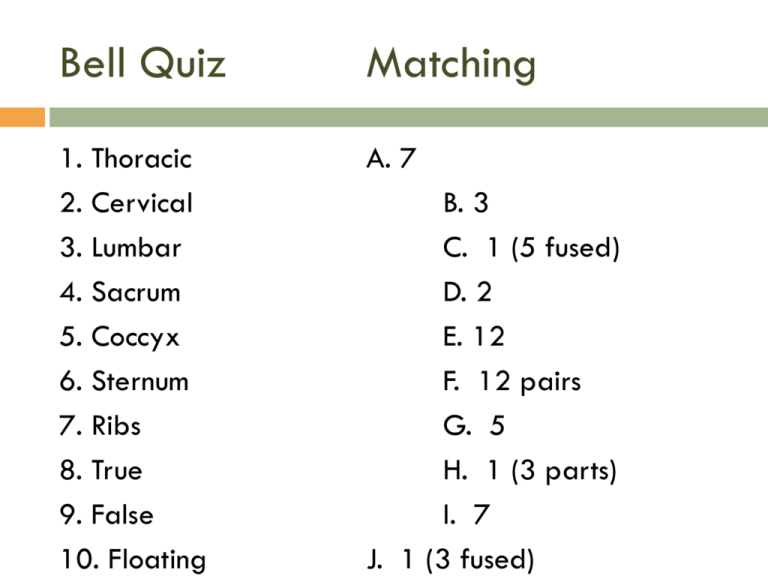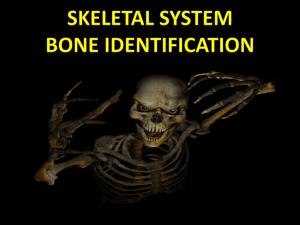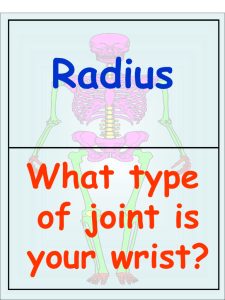Appendicular skeleton - Mrs. Yates' Science Page
advertisement

Bell Quiz Matching 1. Thoracic 2. Cervical 3. Lumbar 4. Sacrum 5. Coccyx 6. Sternum 7. Ribs 8. True 9. False 10. Floating A. 7 B. 3 C. 1 (5 fused) D. 2 E. 12 F. 12 pairs G. 5 H. 1 (3 parts) I. 7 J. 1 (3 fused) APPENDICULAR SKELETON Limbs and base units Pectoral Girdle Connects upper limbs (arms) to axial skeleton. Clavicle Collar bone (2) Scapula Shoulder blade (2) HUMERUS Upper arm, big bone (2) Radius and ulna R= Lower arm, thumb side (2) U= Lower arm, pinky side (2) Olecranon Process Elbow bone on the proximal side of the Ulna Page 149 Funny Bone Dislocated elbow Carpals Wrist bones. Short bones (16) (8 in each wrist) Carpal bones A. scaphoid B. lunate C. triquetrum D. pisiform E. hamate F. capitate G. trapezoid H. trapesium Carpals Sally left the party, to take Cathy home Metacarpals Palm of the hand (10 or 5 in each hand) Phalanges Finger bones (28 or 14 in each hand). Polydactyl Recap in #’s: Totals Clavicle = 2 Scapula = 2 Humerus = 2 Radius = 2 Ulna = 2 Carpals = 16 Metacarpals = 10 Phalanges = 28 TOTAL in the pectoral girdle and arms is: 64 Skull Frontal -1 Parietal -2 Occipital -1 Temporal -2 Sphenoid -1 Ethmoid - 1 Lacremal -2 Nasal Bone -2 Maxilla -2 Zygomatic -2 Mandible -1 Vomer -1 Palantine – 2 Nasal Concha -2 22 total Vertebrae and Ribs Cervical – 7 Thoracic – 12 Lumbar – 5 Sacrum -1 Coccyx – 1 Sternum -1 Ribs – 24 51 Bones Other Ossicles – 6 Hyoid – 1 7 bones Total so far 64+22+51+7 = BONES TO GO 62 144 Activity – Good or Bad? Cracking your knuckles Popping your back or neck Evidence: Valid vs. Invalid Cracking Nuckles Joints (knuckles) are covered by a capsule (the joint capsule or synovial capsule). Within the space of this capsule the synovial fluid is contained which acts as a lubricant and also contains nutrients for the adjacent bone surfaces. A variety of gases are continuously dissolved in this fluid. When one cracks a knuckle, the stretching of the capsule lowers the pressure inside the joint and creates a vacuum which is filled by the gas previously dissolved in the synovial fluid. This creates a “bubble” which then bursts producing the characteristic “popping” or “cracking” sound. It takes a while until these gases are re-dissolved in the synovial fluid which explains why knuckles cannot be “re-cracked” immediately.








